Evaluation of Atmospheric Correction Algorithms for Sentinel-2-MSI and Sentinel-3-OLCI in Highly Turbid Estuarine Waters
Abstract
1. Introduction
2. Materials and Methods
2.1. Study Area
2.2. Data
2.2.1. In-Situ Data
Radiometric Measurements
Automated Turbidity Stations
2.2.2. Satellite Data
2.3. Methods
2.3.1. Bandwidth Correction
2.3.2. Selected Atmospheric Correction Algorithms
AC Algorithms Considered for S2-MSI
AC Algorithms Tested for S3-OLCI
2.3.3. SPM Extraction
2.3.4. Statistical Analyses
2.3.5. Comparison between Acolite SWIR and Acolite DSF
3. Results
3.1. Intercomparison of S2-MSI AC Algorithms
3.2. Evaluation of AC Algorithms for S2-MSI
3.3. Intercomparison of S3-OLCI AC Algorithms
3.4. Evaluation of AC Algorithms for S3-OLCI
3.5. Validation of Satellite-Derived Rhow and SPM Values Based on Match-Ups with Field Data
4. Discussion
4.1. L8-OLI
4.2. S2-MSI
4.3. S3-OLCI
5. Conclusions
Author Contributions
Funding
Acknowledgments
Conflicts of Interest
Abbreviations
| AC | Atmospheric Correction |
| Aeronet | Aerosol Robotic Network |
| AOT | Aerosol Optical Thickness |
| AU | Astronomical Unit |
| BLR | Baseline Residual |
| BAC | OLCI Baseline Atmospheric Correction |
| BPAC | Bright Pixel Atmospheric Correction |
| C2RCC | Case 2 Regional Coast Color |
| CDOM | Colored Dissolved Organic Matter |
| Chl-a | Chlorophyll-a |
| CODA | Copernicus Online Data Access |
| DCS4COP | Data Cube Service for Copernicus |
| DDV | Dark Dense Vegetation |
| DSF | Dark Spectrum Fitting |
| ESA | European Space Agency |
| EUMETSAT | European Organization for the Exploitation of Meteorological Satellites |
| GOCI | Geostationary Ocean Color Imager |
| HW | High Water |
| HYPERMAQ | Hyperspectral and multi-mission high resolution optical remote sensing of aquatic environments |
| iCOR | Image Correction for atmospheric effects |
| IOP | Inherent Optical Property |
| L8 | Landsat-8 |
| LW | Low Water |
| LUT | Look UP Tables |
| MAGEST | MArel Gironde ESTuary |
| MAPE | Mean Absolute Percentage Error |
| MODTRAN | MODerate resolution atmospheric TRANsmission |
| MODIS | MODerate resolution Imaging Spectroradiometer |
| MSI | MultiSpectral Instrument |
| NIR | Near Infra-red |
| NN | Neural Network |
| NRMSE | Normalized Root Mean Square Error |
| NTU | Nephelometric Turbidity Unit |
| OLCI | Ocean and Land Colour Instrument |
| OLI | Operational Land Image |
| Polymer | Polynomial based algorithm applied to MERIS |
| Water-leaving Reflectance | |
| S2 | Sentinel-2 |
| S3 | Sentinel-3 |
| SeaDAS | SeaWiFS Data Analysis System |
| SeaWIFS | Sea-Viewing Wide Field-of-View Sensor |
| SIMEC | SIMilarity Environmental Correction |
| SERT | Semi Empirical Radiative Transfer |
| SNAP | Sentinel Application Platform |
| SPM | Suspended Particulate Matter |
| SWIR | Short Wave Infra-red |
| SRF | Spectral Response Function |
| SZA | Sun zenith angle |
| TMZ | Turbidity Maximum Zone |
| USGS | United States Geological Survey |
| UTC | Universal Time Coordinated |
| Secchi depth |
References
- Novoa, S.; Doxaran, D.; Ody, A.; Vanhellemont, Q.; Lafon, V.; Lubac, B.; Gernez, P. Atmospheric corrections and multi-conditional algorithm for multi-sensor remote sensing of suspended particulate matter in low-to-high turbidity levels coastal waters. Remote Sens. 2017, 9, 61. [Google Scholar] [CrossRef]
- Gordon, H.R. Removal of atmospheric effects from satellite imagery of the oceans. Appl. Opt. 1978, 17, 1631–1636. [Google Scholar] [CrossRef] [PubMed]
- Frouin, R.J.; Franz, B.A.; Ibrahim, A.; Knobelspiesse, K.; Ahmad, Z.; Cairns, B.; Chowdhary, J.; Dierssen, H.M.; Tan, J.; Dubovik, O.; et al. Atmospheric correction of satellite ocean-color imagery during the PACE era. Front. Earth Sci. 2019, 7, 145. [Google Scholar] [CrossRef]
- Wang, M. (Ed.) Atmospheric Correction for Remotely-Sensed Ocean-Colour Products; International Ocean-Colour Coordinating Group: Dartmouth, NS, Canada, 2010; Volume 10. [Google Scholar]
- Wang, M.; Bailey, S.W. Correction of sun glint contamination on the SeaWiFS ocean and atmosphere products. Appl. Opt. 2001, 40, 4790–4798. [Google Scholar] [CrossRef] [PubMed]
- Wang, M. The Rayleigh lookup tables for the SeaWiFS data processing: Accounting for the effects of ocean surface roughness. Int. J. Remote Sens. 2002, 23, 2693–2702. [Google Scholar] [CrossRef]
- Gordon, H.R.; Brown, O.B.; Evans, R.H.; Brown, J.W.; Smith, R.C.; Baker, K.S.; Clark, D.K. A semianalytic radiance model of ocean color. J. Geophys. Res. Atmos. 1988, 93, 10909–10924. [Google Scholar] [CrossRef]
- Mobley, C.; Werdell, J.; Franz, B.; Ahmad, Z.; Bailey, S. Atmospheric Correction for Satellite Ocean Color Radiometry; Technical Report; NASA Goddard Space Flight Center: Greenbelt, MD, USA, 2016. [CrossRef]
- Gordon, H.R.; Wang, M. Retrieval of water-leaving radiance and aerosol optical thickness over the oceans with SeaWiFS: A preliminary algorithm. Appl. Opt. 1994, 33, 443–452. [Google Scholar] [CrossRef]
- Nechad, B.; Ruddick, K.; Park, Y. Calibration and validation of a generic multisensor algorithm for mapping of total suspended matter in turbid waters. Remote Sens. Environ. 2010, 114, 854–866. [Google Scholar] [CrossRef]
- Siegel, D.A.; Wang, M.; Maritorena, S.; Robinson, W. Atmospheric correction of satellite ocean color imagery: The black pixel assumption. Appl. Opt. 2000, 39, 3582–3591. [Google Scholar] [CrossRef]
- Shi, W.; Wang, M. An assessment of the black ocean pixel assumption for MODIS SWIR bands. Remote Sens. Environ. 2009, 113, 1587–1597. [Google Scholar] [CrossRef]
- Ruddick, K.G.; Ovidio, F.; Rijkeboer, M. Atmospheric correction of SeaWiFS imagery for turbid coastal and inland waters. Appl. Opt. 2000, 39, 897–912. [Google Scholar] [CrossRef] [PubMed]
- Stumpf, R.; Arnone, R.; Gould, R.; Martinolich, P.; Ransibrahmanakul, V. A partially coupled ocean-atmosphere model for retrieval of water-leaving radiance from SeaWiFS in coastal waters. NASA Tech. Memo 2003, 206892, 51–59. [Google Scholar]
- Lavender, S.; Pinkerton, M.; Moore, G.; Aiken, J.; Blondeau-Patissier, D. Modification to the atmospheric correction of SeaWiFS ocean colour images over turbid waters. Cont. Shelf Res. 2005, 25, 539–555. [Google Scholar] [CrossRef]
- Wang, M. Remote sensing of the ocean contributions from ultraviolet to near-infrared using the shortwave infrared bands: Simulations. Appl. Opt. 2007, 46, 1535–1547. [Google Scholar] [CrossRef] [PubMed]
- Shi, W.; Wang, M. Detection of turbid waters and absorbing aerosols for the MODIS ocean color data processing. Remote Sens. Environ. 2007, 110, 149–161. [Google Scholar] [CrossRef]
- Wang, M.; Shi, W. The NIR-SWIR combined atmospheric correction approach for MODIS ocean color data processing. Opt. Express 2007, 15, 15722–15733. [Google Scholar] [CrossRef]
- Wang, M.; Son, S.; Shi, W. Evaluation of MODIS SWIR and NIR-SWIR atmospheric correction algorithms using SeaBASS data. Remote Sens. Environ. 2009, 113, 635–644. [Google Scholar] [CrossRef]
- Moore, G.; Aiken, J.; Lavender, S. The atmospheric correction of water colour and the quantitative retrieval of suspended particulate matter in Case II waters: Application to MERIS. Int. J. Remote Sens. 1999, 20, 1713–1733. [Google Scholar] [CrossRef]
- Shen, F.; Verhoef, W.; Zhou, Y.; Salama, M.S.; Liu, X. Satellite estimates of wide-range suspended sediment concentrations in Changjiang (Yangtze) estuary using MERIS data. Estuar. Coast 2010, 33, 1420–1429. [Google Scholar] [CrossRef]
- Brockmann, C.; Doerffer, R.; Peters, M.; Kerstin, S.; Embacher, S.; Ruescas, A. Evolution of the C2RCC neural network for Sentinel 2 and 3 for the retrieval of ocean colour products in normal and extreme optically complex waters. In Proceedings of the Living Planet Symposium, Prague, Czech Republic, 9–13 May 2016; Volume 740, p. 54. [Google Scholar]
- Steinmetz, F.; Deschamps, P.Y.; Ramon, D. Atmospheric correction in presence of sun glint: Application to MERIS. Opt. Express 2011, 19, 9783–9800. [Google Scholar] [CrossRef]
- Vanhellemont, Q.; Ruddick, K. Advantages of high quality SWIR bands for ocean colour processing: Examples from Landsat-8. Remote Sens. Environ. 2015, 161, 89–106. [Google Scholar] [CrossRef]
- Vanhellemont, Q.; Ruddick, K. Acolite for Sentinel-2: Aquatic applications of MSI imagery. In Proceedings of the 2016 ESA Living Planet Symposium, Prague, Czech Republic, 9–13 May 2016; pp. 9–13. [Google Scholar]
- Vanhellemont, Q.; Ruddick, K. Atmospheric correction of metre-scale optical satellite data for inland and coastal water applications. Remote Sens. Environ. 2018, 216, 586–597. [Google Scholar] [CrossRef]
- Vanhellemont, Q. Adaptation of the dark spectrum fitting atmospheric correction for aquatic applications of the Landsat and Sentinel-2 archives. Remote Sens. Environ. 2019, 225, 175–192. [Google Scholar] [CrossRef]
- Jamet, C.; Loisel, H.; Kuchinke, C.P.; Ruddick, K.; Zibordi, G.; Feng, H. Comparison of three SeaWiFS atmospheric correction algorithms for turbid waters using AERONET-OC measurements. Remote Sens. Environ. 2011, 115, 1955–1965. [Google Scholar] [CrossRef]
- Goyens, C.; Jamet, C.; Schroeder, T. Evaluation of four atmospheric correction algorithms for MODIS-Aqua images over contrasted coastal waters. Remote Sens. Environ. 2013, 131, 63–75. [Google Scholar] [CrossRef]
- Huang, X.; Zhu, J.; Han, B.; Jamet, C.; Tian, Z.; Zhao, Y.; Li, J.; Li, T. Evaluation of Four Atmospheric Correction Algorithms for GOCI Images over the Yellow Sea. Remote Sens. 2019, 11, 1631. [Google Scholar] [CrossRef]
- Pahlevan, N.; Schott, J.R.; Franz, B.A.; Zibordi, G.; Markham, B.; Bailey, S.; Schaaf, C.B.; Ondrusek, M.; Greb, S.; Strait, C.M. Landsat 8 remote sensing reflectance (Rrs) products: Evaluations, intercomparisons, and enhancements. Remote Sens. Environ. 2017, 190, 289–301. [Google Scholar] [CrossRef]
- Abascal Zorrilla, N.; Vantrepotte, V.; Gensac, E.; Huybrechts, N.; Gardel, A. The Advantages of Landsat 8-OLI-Derived Suspended Particulate Matter Maps for Monitoring the Subtidal Extension of Amazonian Coastal Mud Banks (French Guiana). Remote Sens. 2018, 10, 1733. [Google Scholar] [CrossRef]
- Chaichitehrani, N.; Hestir, E.L.; Li, C. Evaluation of Atmospheric Correction Algorithms for Landsat-8 OLI and MODIS-Aqua to Study Sediment Dynamics in the Northern Gulf of Mexico. Adv. Remote Sens. 2018, 7, 101. [Google Scholar] [CrossRef][Green Version]
- Ilori, C.O.; Pahlevan, N.; Knudby, A. Analyzing Performances of Different Atmospheric Correction Techniques for Landsat 8: Application for Coastal Remote Sensing. Remote Sens. 2019, 11, 469. [Google Scholar] [CrossRef]
- Wang, D.; Ma, R.; Xue, K.; Loiselle, S.A. The Assessment of Landsat-8 OLI Atmospheric Correction Algorithms for Inland Waters. Remote Sens. 2019, 11, 169. [Google Scholar] [CrossRef]
- Doxani, G.; Vermote, E.; Roger, J.C.; Gascon, F.; Adriaensen, S.; Frantz, D.; Hagolle, O.; Hollstein, A.; Kirches, G.; Li, F.; et al. Atmospheric correction inter-comparison exercise. Remote Sens. 2018, 10, 352. [Google Scholar] [CrossRef]
- Martins, V.; Barbosa, C.; de Carvalho, L.; Jorge, D.; Lobo, F.; Novo, E. Assessment of atmospheric correction methods for Sentinel-2 MSI images applied to Amazon floodplain lakes. Remote Sens. 2017, 9, 322. [Google Scholar] [CrossRef]
- Caballero, I.; Steinmetz, F.; Navarro, G. Evaluation of the first year of operational Sentinel-2A data for retrieval of suspended solids in medium-to high-turbidity waters. Remote Sens. 2018, 10, 982. [Google Scholar] [CrossRef]
- König, M.; Oppelt, N.M.; Hieronymi, M. Application of Sentinel-2 MSI in Arctic research: Evaluating the performance of atmospheric correction approaches over Arctic sea ice. Front. Earth Sci. 2019, 7, 22. [Google Scholar] [CrossRef]
- Pereira-Sandoval, M.; Ruescas, A.; Urrego, P.; Ruiz-Verdú, A.; Delegido, J.; Tenjo, C.; Soria-Perpinyà, X.; Vicente, E.; Soria, J.; Moreno, J. Evaluation of Atmospheric Correction Algorithms over Spanish Inland Waters for Sentinel-2 Multi Spectral Imagery Data. Remote Sens. 2019, 11, 1469. [Google Scholar] [CrossRef]
- Warren, M.A.; Simis, S.G.; Martinez-Vicente, V.; Poser, K.; Bresciani, M.; Alikas, K.; Spyrakos, E.; Giardino, C.; Ansper, A. Assessment of atmospheric correction algorithms for the Sentinel-2A MultiSpectral Imager over coastal and inland waters. Remote Sens. Environ. 2019, 225, 267–289. [Google Scholar] [CrossRef]
- Bi, S.; Li, Y.; Wang, Q.; Lyu, H.; Liu, G.; Zheng, Z.; Du, C.; Mu, M.; Xu, J.; Lei, S.; et al. Inland water Atmospheric Correction based on Turbidity Classification using OLCI and SLSTR synergistic observations. Remote Sens. 2018, 10, 1002. [Google Scholar] [CrossRef]
- Mograne, M.A.; Jamet, C.; Loisel, H.; Vantrepotte, V.; Mériaux, X.; Cauvin, A. Evaluation of Five Atmospheric Correction Algorithms over French Optically-Complex Waters for the Sentinel-3A OLCI Ocean Color Sensor. Remote Sens. 2019, 11, 668. [Google Scholar] [CrossRef]
- Zibordi, G.; Mélin, F.; Berthon, J.F.; Talone, M. In situ autonomous optical radiometry measurements for satellite ocean color validation in the Western Black Sea. Ocean Sci. 2015, 11. [Google Scholar] [CrossRef]
- Zibordi, G.; Mélin, F.; Berthon, J.F. A regional assessment of OLCI data products. IEEE Geosci. Remote Sens. Lett. 2018, 15, 1490–1494. [Google Scholar] [CrossRef]
- Bonneton, P.; Bonneton, N.; Parisot, J.P.; Castelle, B. Tidal bore dynamics in funnel-shaped estuaries. J. Geophys. Res. Oceans 2015, 120, 923–941. [Google Scholar] [CrossRef]
- Uncles, R.; Stephens, J.; Smith, R. The dependence of estuarine turbidity on tidal intrusion length, tidal range and residence time. Cont. Shelf Res. 2002, 22, 1835–1856. [Google Scholar] [CrossRef]
- Sottolichio, A.; Castaing, P. A synthesis on seasonal dynamics of highly-concentrated structures in the Gironde estuary. Comptes Rendus de l’Académie des Sci.-Ser. IIA-Earth Planet. Sci. 1999, 329, 795–800. [Google Scholar] [CrossRef]
- Doxaran, D.; Froidefond, J.M.; Lavender, S.; Castaing, P. Spectral signature of highly turbid waters: Application with SPOT data to quantify suspended particulate matter concentrations. Remote Sens. Environ. 2002, 81, 149–161. [Google Scholar] [CrossRef]
- Doxaran, D.; Froidefond, J.M.; Castaing, P. A reflectance band ratio used to estimate suspended matter concentrations in sediment-dominated coastal waters. Int. J. Remote Sens. 2002, 23, 5079–5085. [Google Scholar] [CrossRef]
- Doxaran, D.; Froidefond, J.M.; Castaing, P. Remote-sensing reflectance of turbid sediment-dominated waters. Reduction of sediment type variations and changing illumination conditions effects by use of reflectance ratios. Appl. Opt. 2003, 42, 2623–2634. [Google Scholar] [CrossRef]
- Doxaran, D.; Castaing, P.; Lavender, S. Monitoring the maximum turbidity zone and detecting fine-scale turbidity features in the Gironde estuary using high spatial resolution satellite sensor (SPOT HRV, Landsat ETM+) data. Int. J. Remote Sens. 2006, 27, 2303–2321. [Google Scholar] [CrossRef]
- Doxaran, D.; Froidefond, J.M.; Castaing, P.; Babin, M. Dynamics of the turbidity maximum zone in a macrotidal estuary (the Gironde, France): Observations from field and MODIS satellite data. Estuar. Coast. Shelf Sci. 2009, 81, 321–332. [Google Scholar] [CrossRef]
- Savoye, N.; David, V.; Morisseau, F.; Etcheber, H.; Abril, G.; Billy, I.; Charlier, K.; Oggian, G.; Derriennic, H.; Sautour, B. Origin and composition of particulate organic matter in a macrotidal turbid estuary: The Gironde Estuary, France. Estuar. Coast. Shelf Sci. 2012, 108, 16–28. [Google Scholar] [CrossRef]
- Gernez, P.; Lafon, V.; Lerouxel, A.; Curti, C.; Lubac, B.; Cerisier, S.; Barillé, L. Toward Sentinel-2 high resolution remote sensing of suspended particulate matter in very turbid waters: SPOT4 (Take5) Experiment in the Loire and Gironde Estuaries. Remote Sens. 2015, 7, 9507–9528. [Google Scholar] [CrossRef]
- Knaeps, E.; Ruddick, K.; Doxaran, D.; Dogliotti, A.I.; Nechad, B.; Raymaekers, D.; Sterckx, S. A SWIR based algorithm to retrieve total suspended matter in extremely turbid waters. Remote Sens. Environ. 2015, 168, 66–79. [Google Scholar] [CrossRef]
- Jalón-Rojas, I.; Schmidt, S.; Sottolichio, A. Turbidity in the fluvial Gironde Estuary (southwest France) based on 10-year continuous monitoring: Sensitivity to hydrological conditions. Hydrol Earth Syst. Sci. 2015, 19, 2805–2819. [Google Scholar] [CrossRef]
- Knaeps, E.; Doxaran, D.; Dogliotti, A.; Nechad, B.; Ruddick, K.; Raymaekers, D.; Sterckx, S. The SeaSWIR dataset. Earth Syst. Sci. Data 2018, 10, 1439–1449. [Google Scholar] [CrossRef]
- Mobley, C.D. Estimation of the remote-sensing reflectance from above-surface measurements. Appl. Opt. 1999, 38, 7442–7455. [Google Scholar] [CrossRef]
- Mueller, L.J.; Morel, A.; Frouin, R.; Davis, C.; Arnone, R.; Carder, K.; Li, Z.; Steward, R.; Hooker, S.; Mobley, C.; et al. Ocean Optics Protocols for Satellite Ocean Color Sensor Validation, Revision 4, Volume III: Radiometric Measurements and Data Analysis Protocols; Technical Report NASA/TM-2003-21621/Rev-Vol III; NASA Goddard Space Flight Center: Greenbelt, MD, USA, 2003.
- Etcheber, H.; Schmidt, S.; Sottolichio, A.; Maneux, E.; Chabaux, G.; Escalier, J.M.; Wennekes, H.; Derriennic, H.; Schmeltz, M.; Quéméner, L.; et al. Monitoring water quality in estuarine environments: Lessons from the MAGEST monitoring program in the Gironde fluvial-estuarine system. Hydrol Earth Syst. Sci. 2011. [Google Scholar] [CrossRef]
- Schmidt, S.; Ouamar, L.; Cosson, B.; Lebleu, P.; Derriennic, H. Monitoring turbidity as a surrogate of suspended particulate load in the Gironde Estuary: The impact of particle size on concentration estimates. In Proceedings of the ISOBAY XIV International Symposium on Oceanography of the Bay of Biscay, Bordeaux, France, 11–13 June 2014; p. 17. [Google Scholar]
- Saulquin, B.; Fablet, R.; Bourg, L.; Mercier, G.; d’Andon, O.F. MEETC2: Ocean color atmospheric corrections in coastal complex waters using a Bayesian latent class model and potential for the incoming sentinel 3—OLCI mission. Remote Sens. Environ. 2016, 172, 39–49. [Google Scholar] [CrossRef]
- Fan, Y.; Li, W.; Gatebe, C.K.; Jamet, C.; Zibordi, G.; Schroeder, T.; Stamnes, K. Atmospheric correction over coastal waters using multilayer neural networks. Remote Sens. Environ. 2017, 199, 218–240. [Google Scholar] [CrossRef]
- De Keukelaere, L.; Sterckx, S.; Adriaensen, S.; Knaeps, E.; Reusen, I.; Giardino, C.; Bresciani, M.; Hunter, P.; Neil, C.; Van der Zande, D.; et al. Atmospheric correction of Landsat-8/OLI and Sentinel-2/MSI data using iCOR algorithm: Validation for coastal and inland waters. Eur. J. Remote Sens. 2018, 51, 525–542. [Google Scholar] [CrossRef]
- Sterckx, S.; Knaeps, S.; Kratzer, S.; Ruddick, K. SIMilarity Environment Correction (SIMEC) applied to MERIS data over inland and coastal waters. Remote Sens. Environ. 2015, 157, 96–110. [Google Scholar] [CrossRef]
- Doerffer, R.; Schiller, H. The MERIS Case 2 water algorithm. Int. J. Remote Sens. 2007, 28, 517–535. [Google Scholar] [CrossRef]
- Ruddick, K.G.; De Cauwer, V.; Park, Y.J.; Moore, G. Seaborne measurements of near infrared water-leaving reflectance: The similarity spectrum for turbid waters. Limnol. Oceanogr. 2006, 51, 1167–1179. [Google Scholar] [CrossRef]
- Antoine, D.; Morel, A. Relative importance of multiple scattering by air molecules and aerosols in forming the atmospheric path radiance in the visible and near-infrared parts of the spectrum. Appl. Opt. 1998, 37, 2245–2259. [Google Scholar] [CrossRef] [PubMed]
- Antoine, D.; Morel, A. A multiple scattering algorithm for atmospheric correction of remotely sensed ocean colour (MERIS instrument): Principle and implementation for atmospheres carrying various aerosols including absorbing ones. Int. J. Remote Sens. 1999, 20, 1875–1916. [Google Scholar] [CrossRef]
- Moore, G.; Mazeran, C.; Huot, J.P. MERIS ATBD 2.6 Case II Bright Pixel Atmospheric Correction (BPAC). Eur. Space Agency 2017, 5, 3. [Google Scholar]
- Nobileau, D.; Antoine, D. Detection of blue-absorbing aerosols using near infrared and visible (ocean color) remote sensing observations. Remote Sens. Environ. 2005, 95, 368–387. [Google Scholar] [CrossRef]
- Gossn, J.I.; Ruddick, K.G.; Dogliotti, A.I. Atmospheric Correction of OLCI Imagery over Extremely Turbid Waters Based on the Red, NIR and 1016 nm Bands and a New Baseline Residual Technique. Remote Sens. 2019, 11, 220. [Google Scholar] [CrossRef]
- Luo, Y.; Doxaran, D.; Vanhellemont, Q. Retrieval and Validation of Water Turbidity at Metre-Scale Using Pléiades Satellite Data: A Case Study in the Gironde Estuary. Remote Sens. 2020, 12, 946. [Google Scholar] [CrossRef]
- Tanre, D.; Herman, M.; Deschamps, P. Influence of the background contribution upon space measurements of ground reflectance. Appl. Opt. 1981, 20, 3676–3684. [Google Scholar] [CrossRef]
- Gordon, H.R.; Wang, M. Influence of oceanic whitecaps on atmospheric correction of ocean-color sensors. Appl. Opt. 1994, 33, 7754–7763. [Google Scholar] [CrossRef]
- Ahmad, Z.; Franz, B.A.; McClain, C.R.; Kwiatkowska, E.J.; Werdell, J.; Shettle, E.P.; Holben, B.N. New aerosol models for the retrieval of aerosol optical thickness and normalized water-leaving radiances from the SeaWiFS and MODIS sensors over coastal regions and open oceans. Appl. Opt. 2010, 49, 5545–5560. [Google Scholar] [CrossRef] [PubMed]
- Bailey, S.W.; Franz, B.A.; Werdell, P.J. Estimation of near-infrared water-leaving reflectance for satellite ocean color data processing. Opt. Express 2010, 18, 7521–7527. [Google Scholar] [CrossRef] [PubMed]
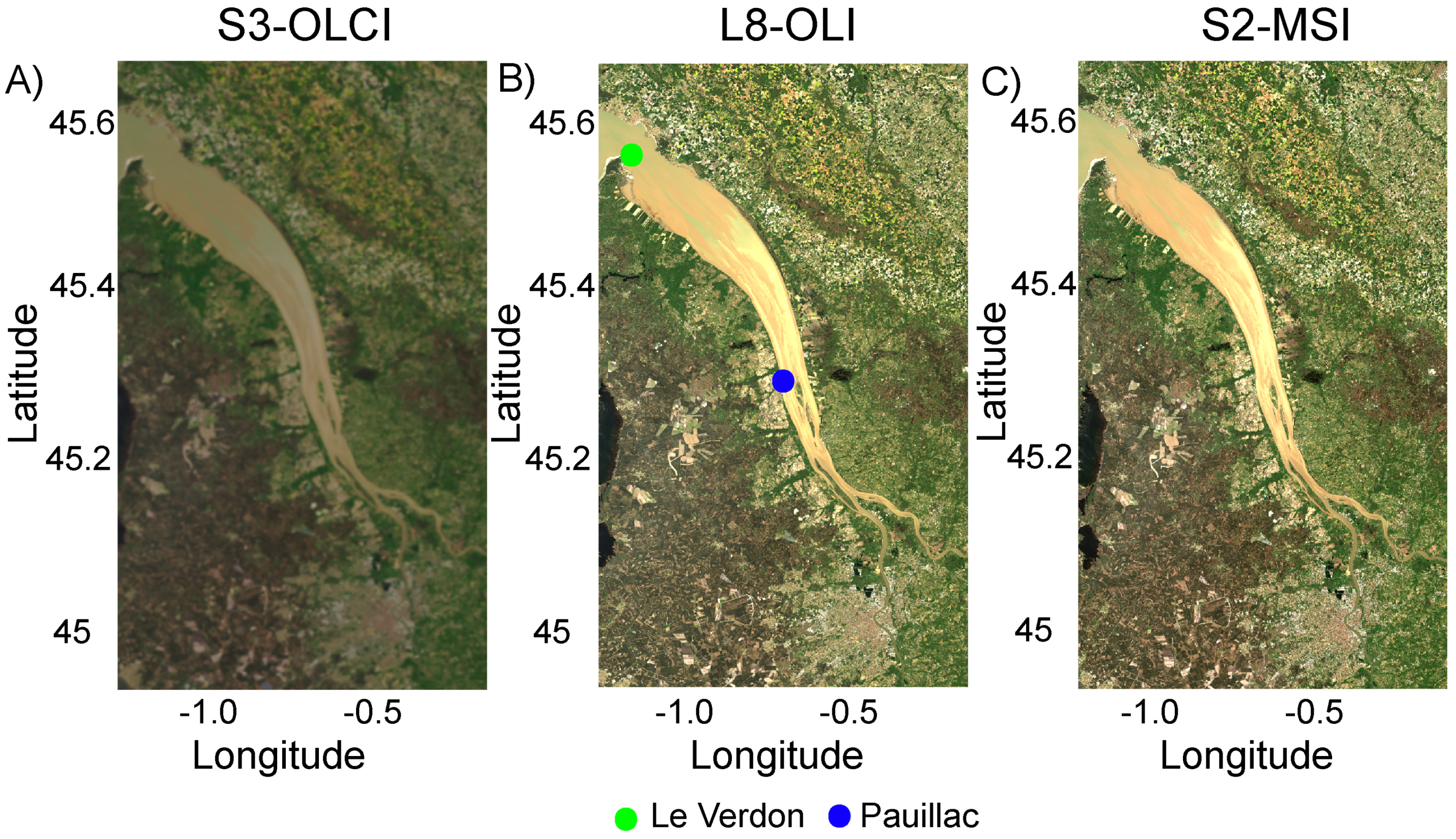
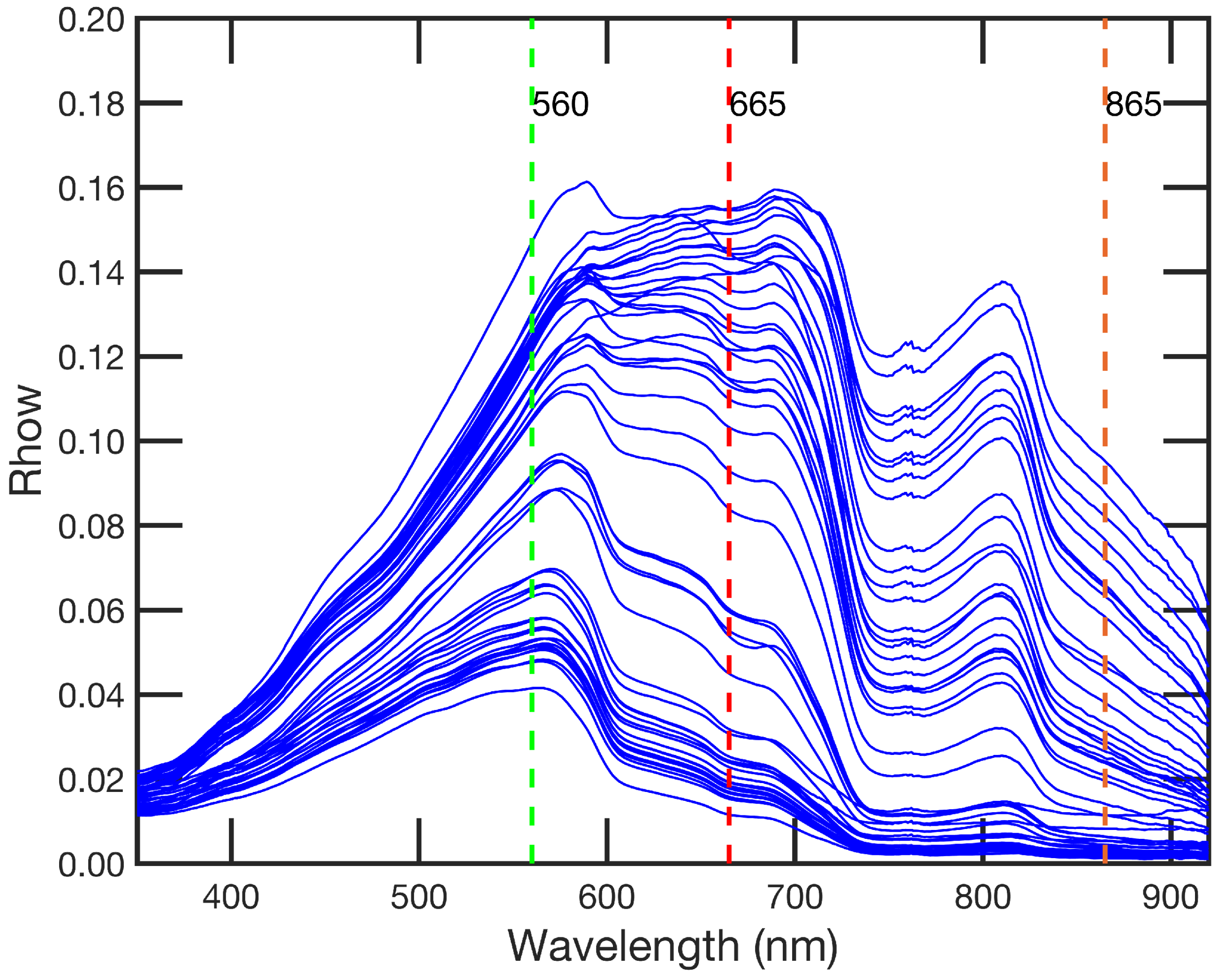
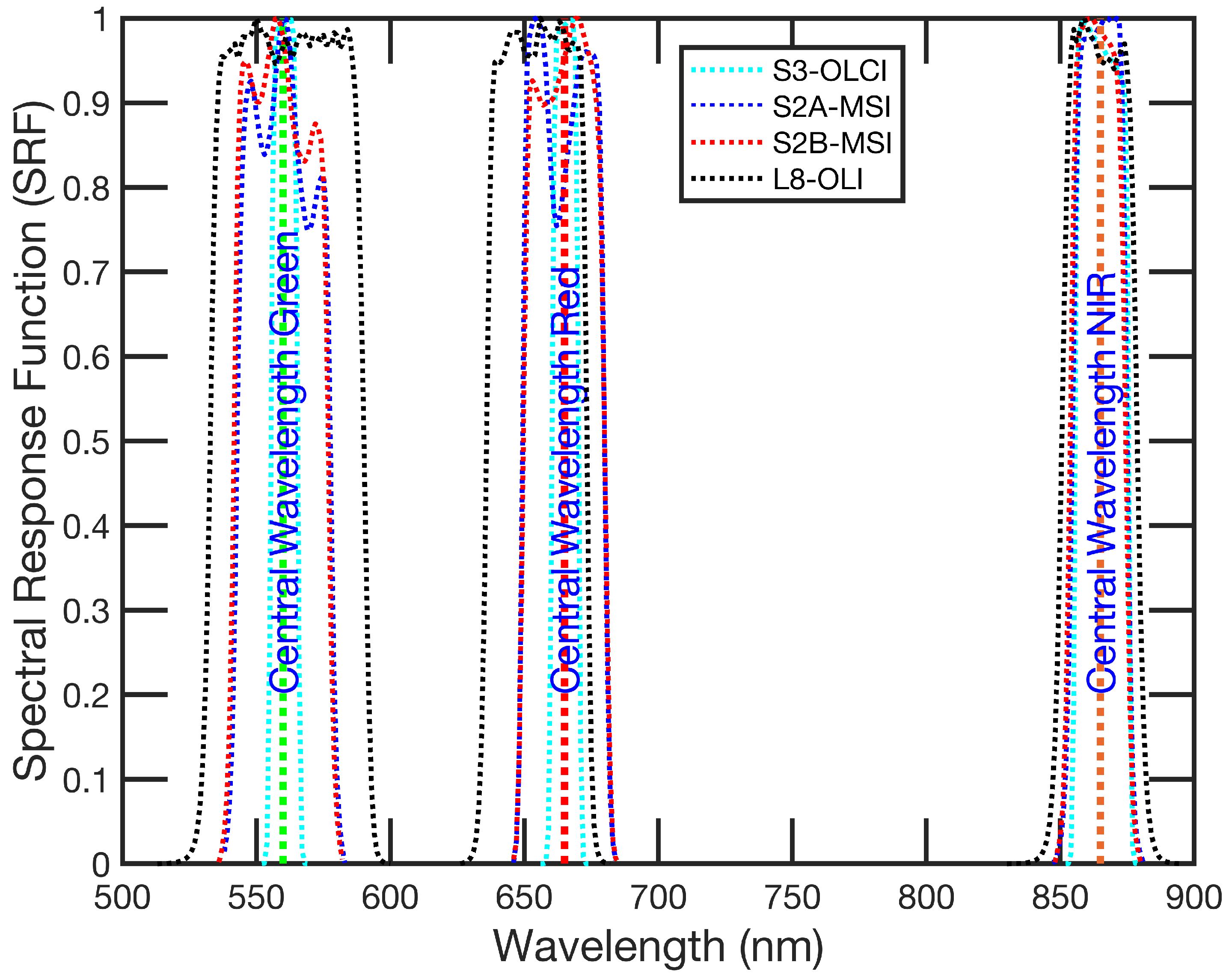
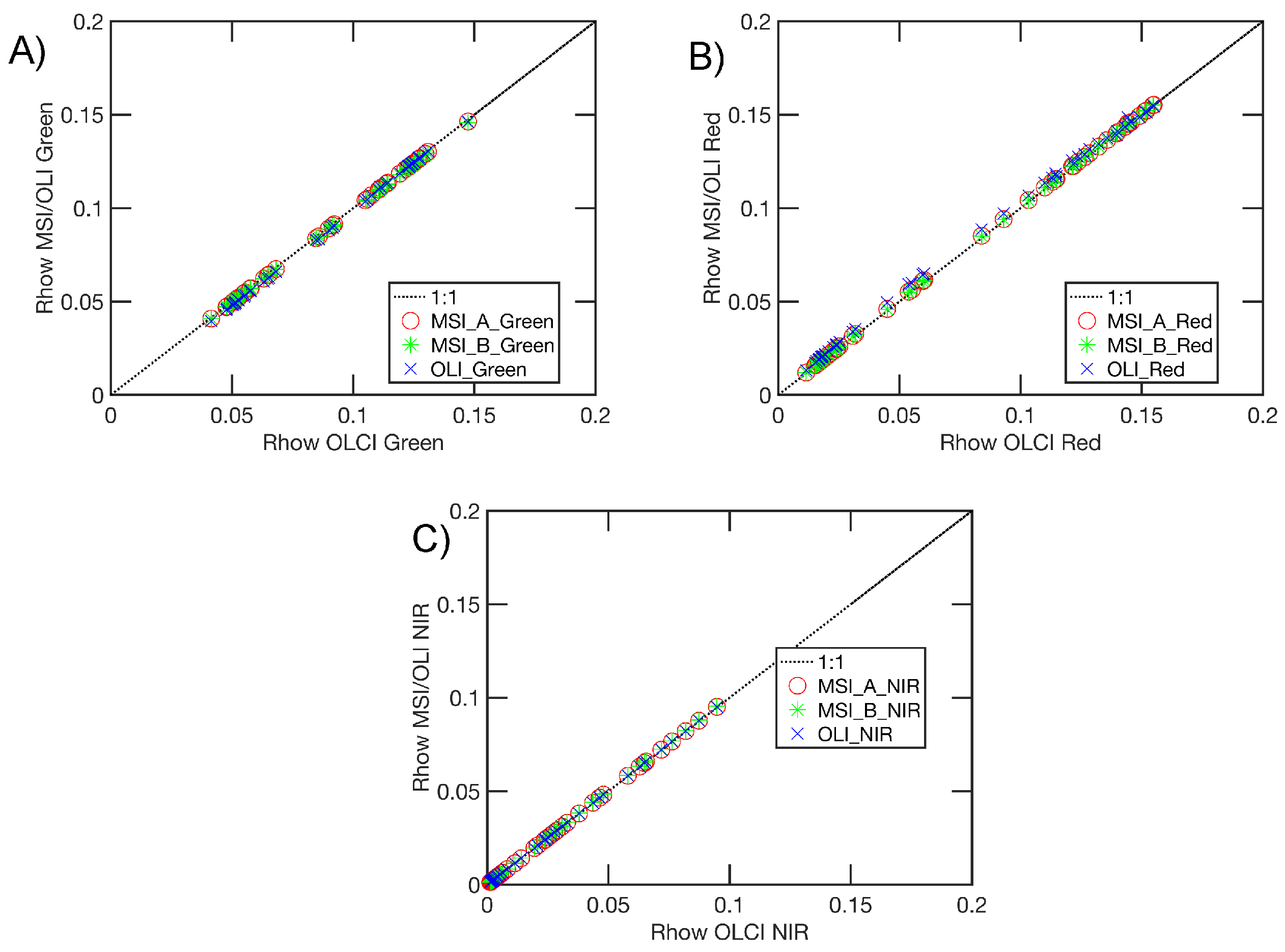
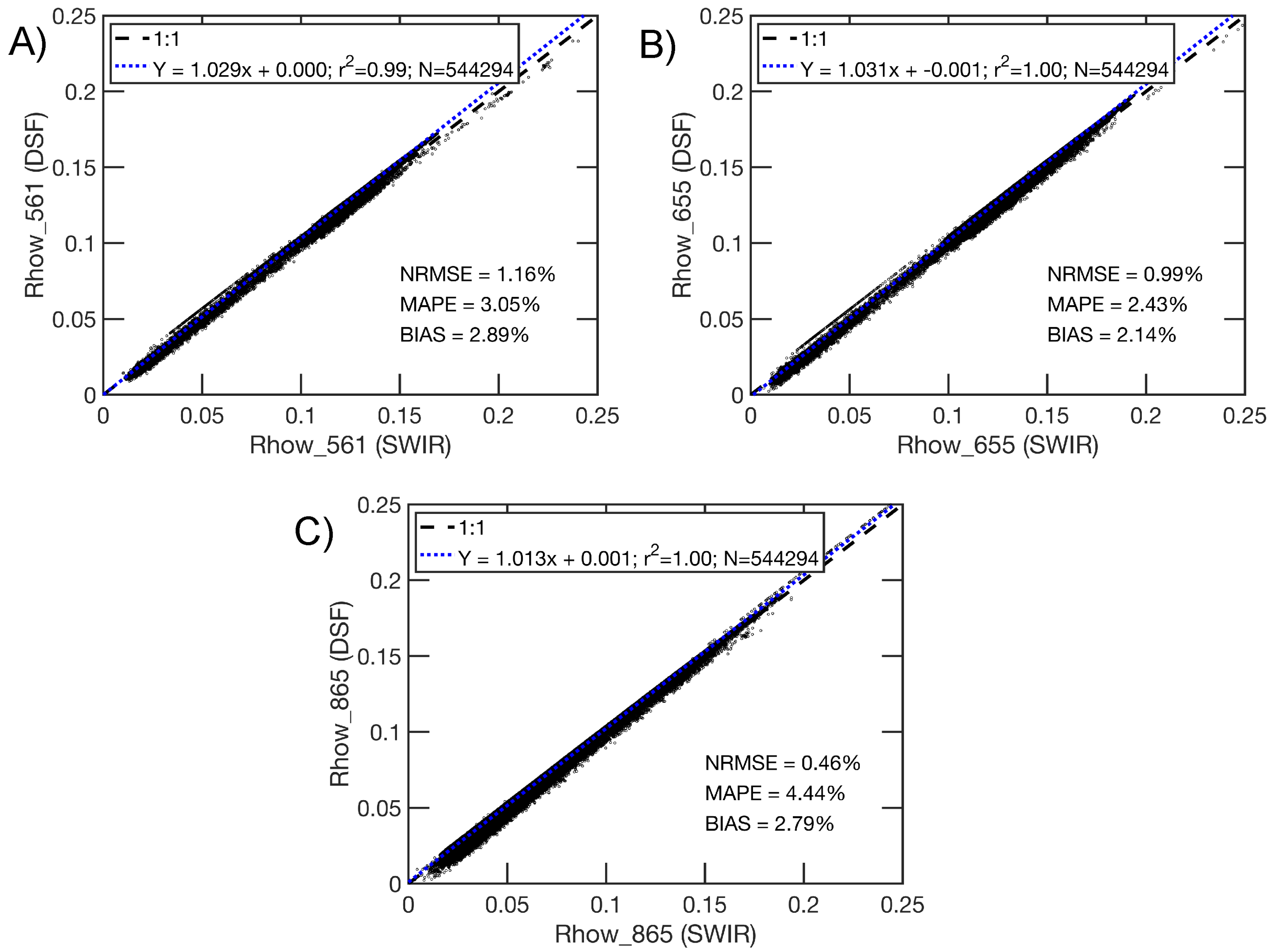
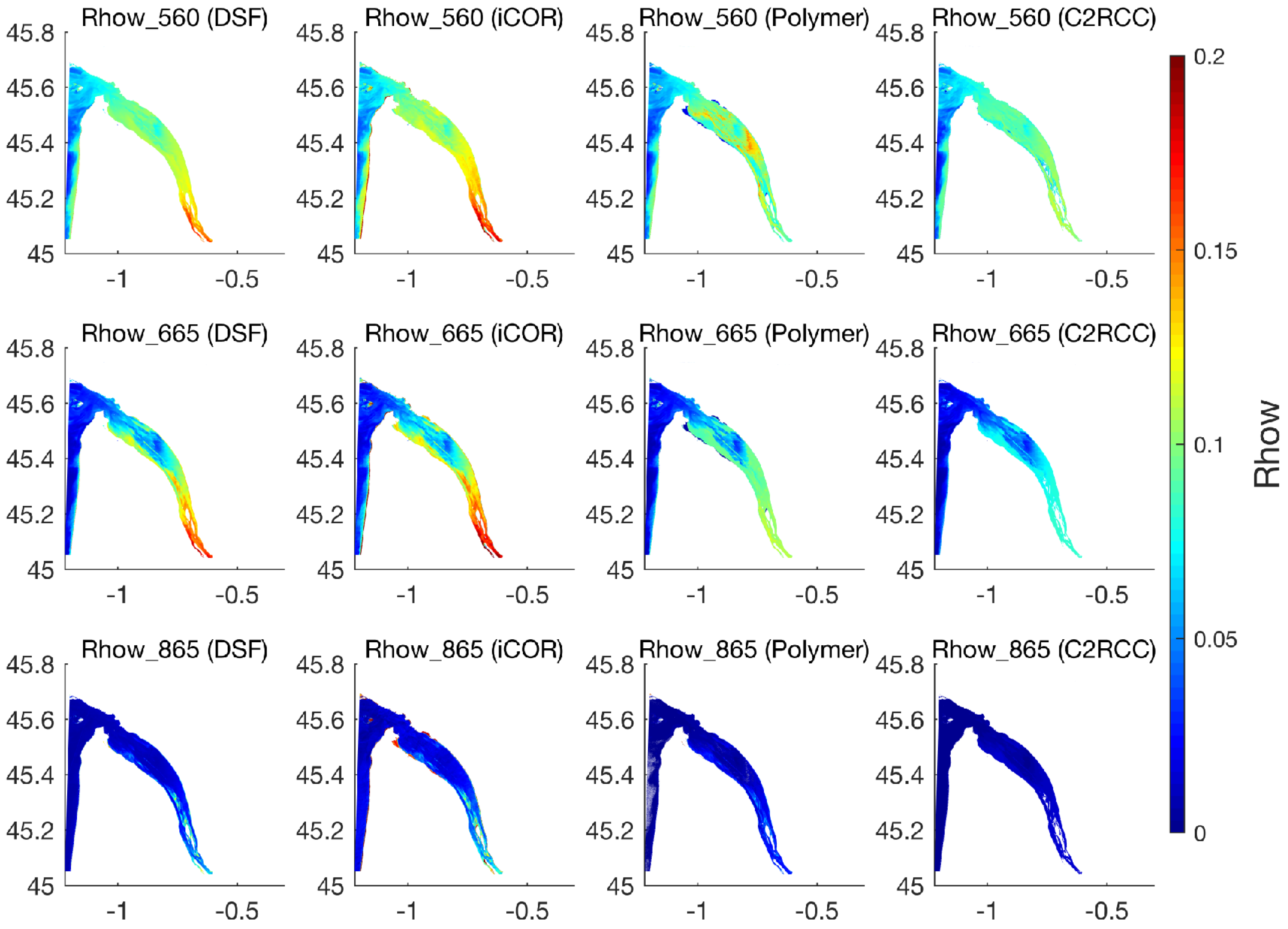
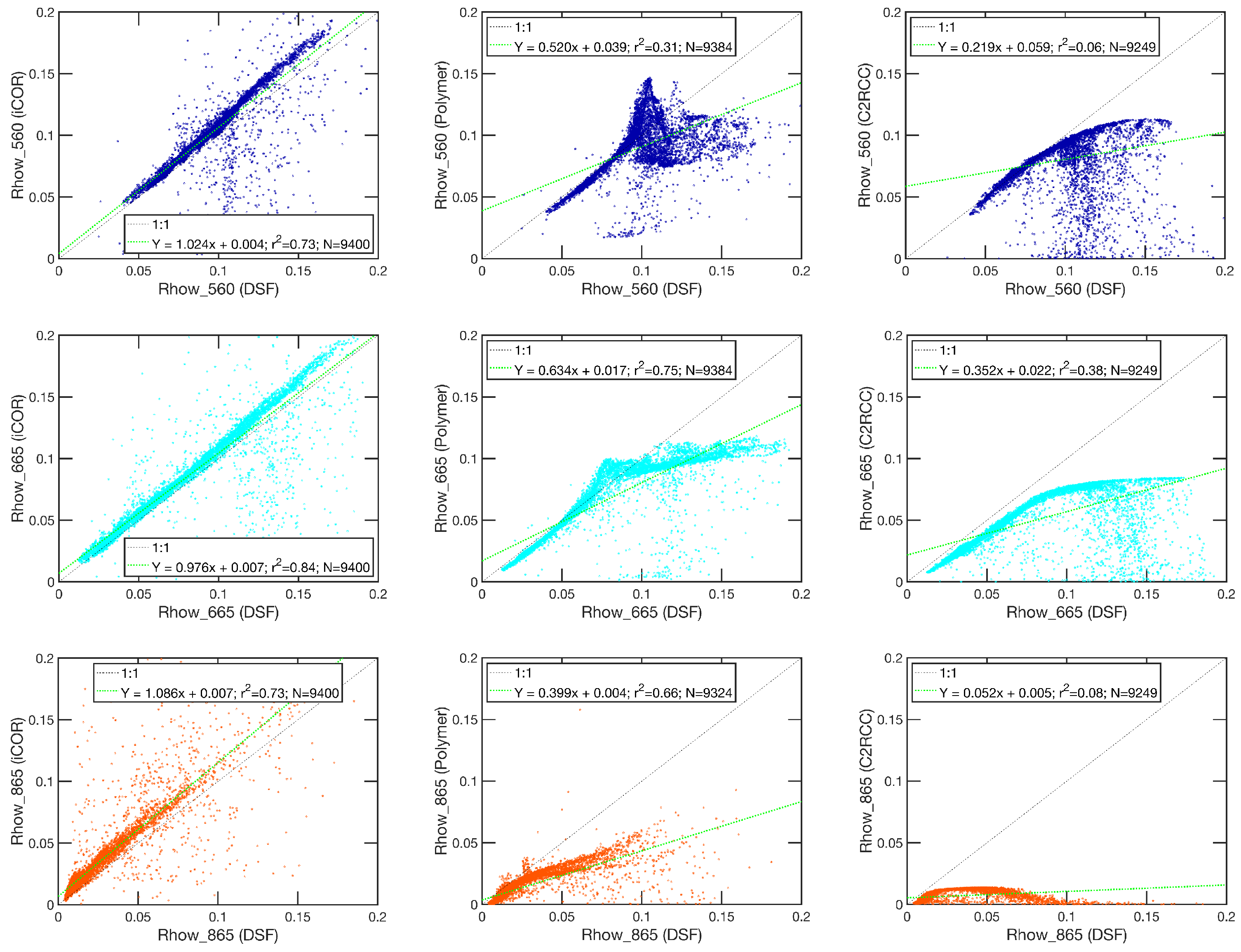
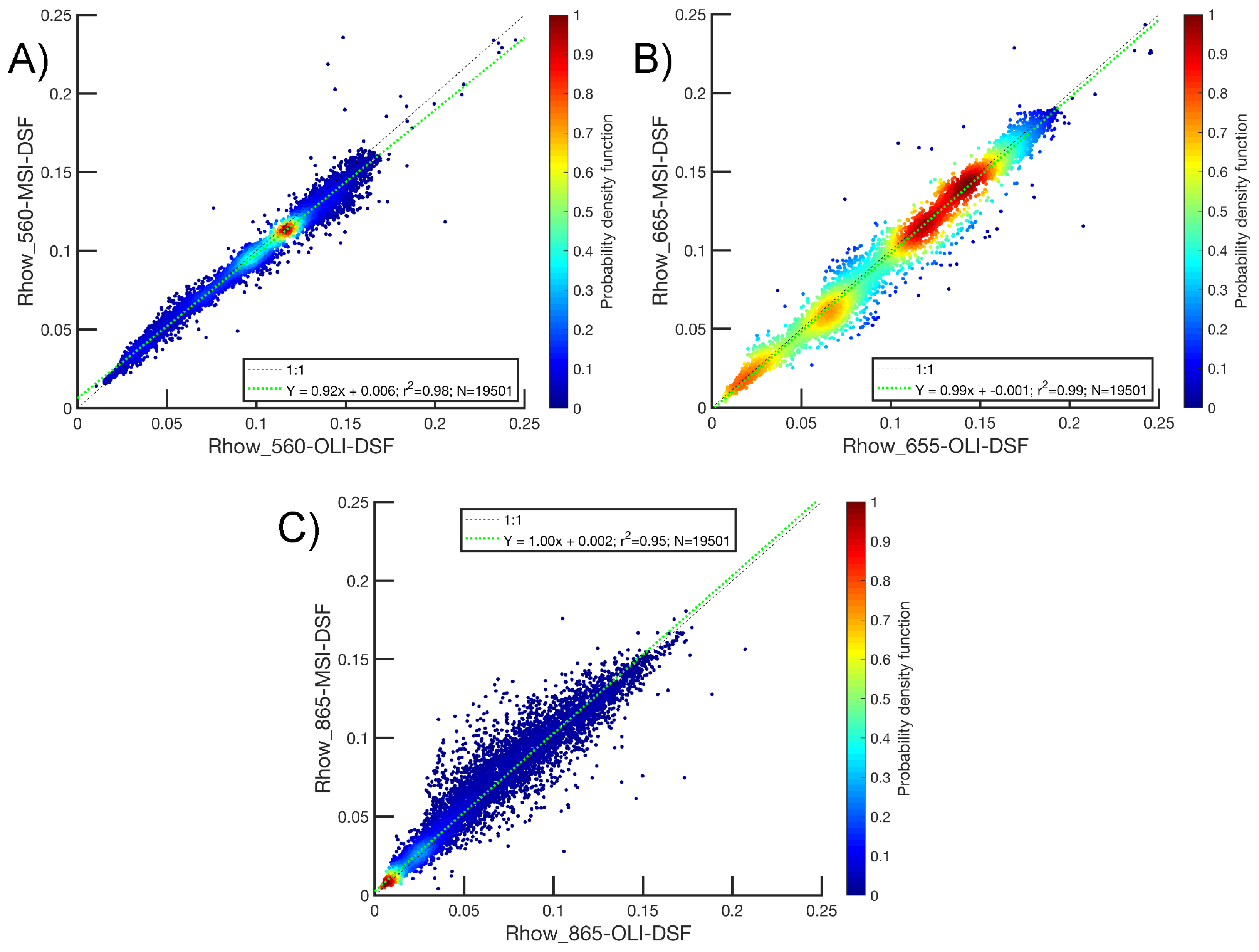
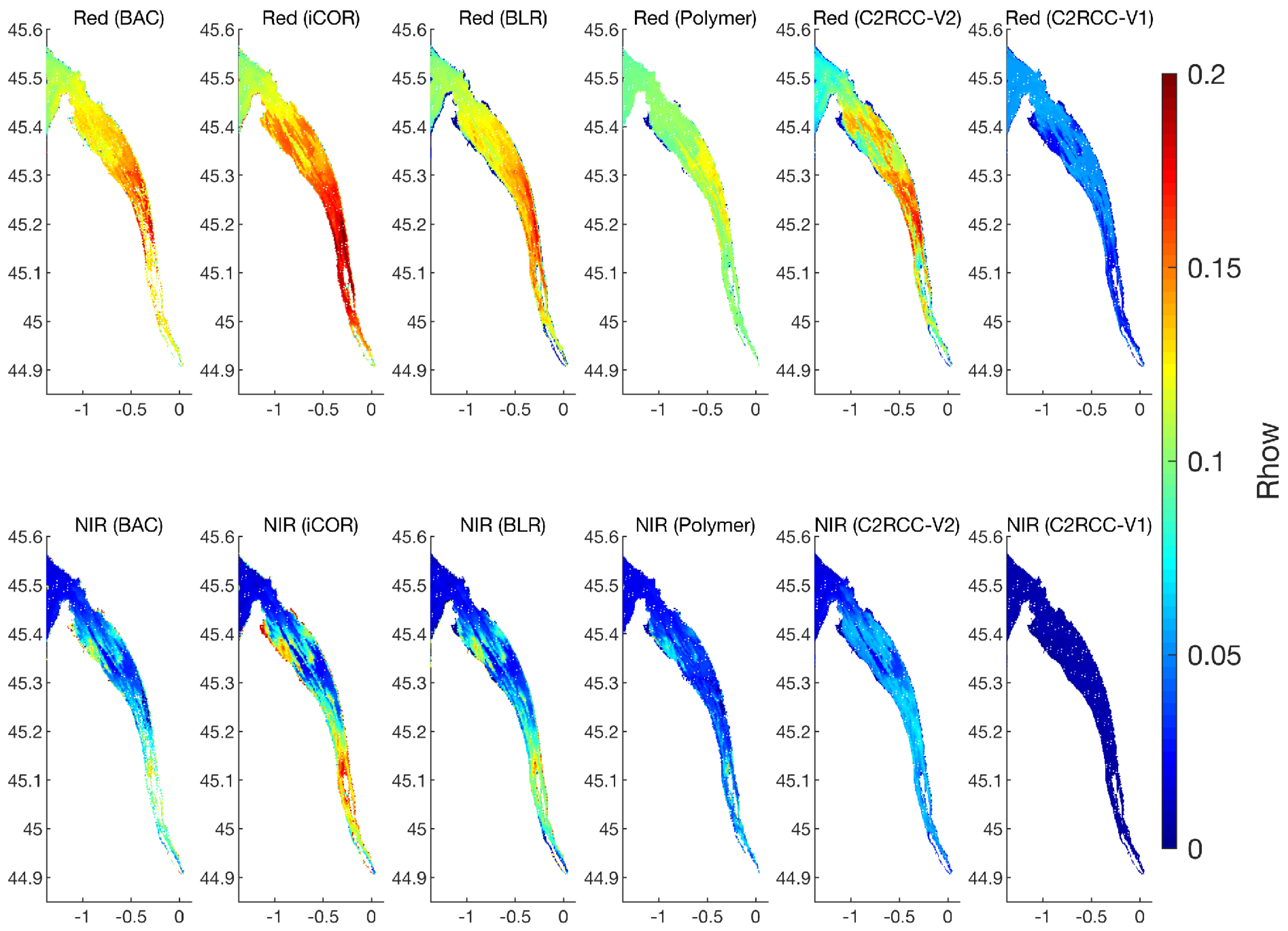
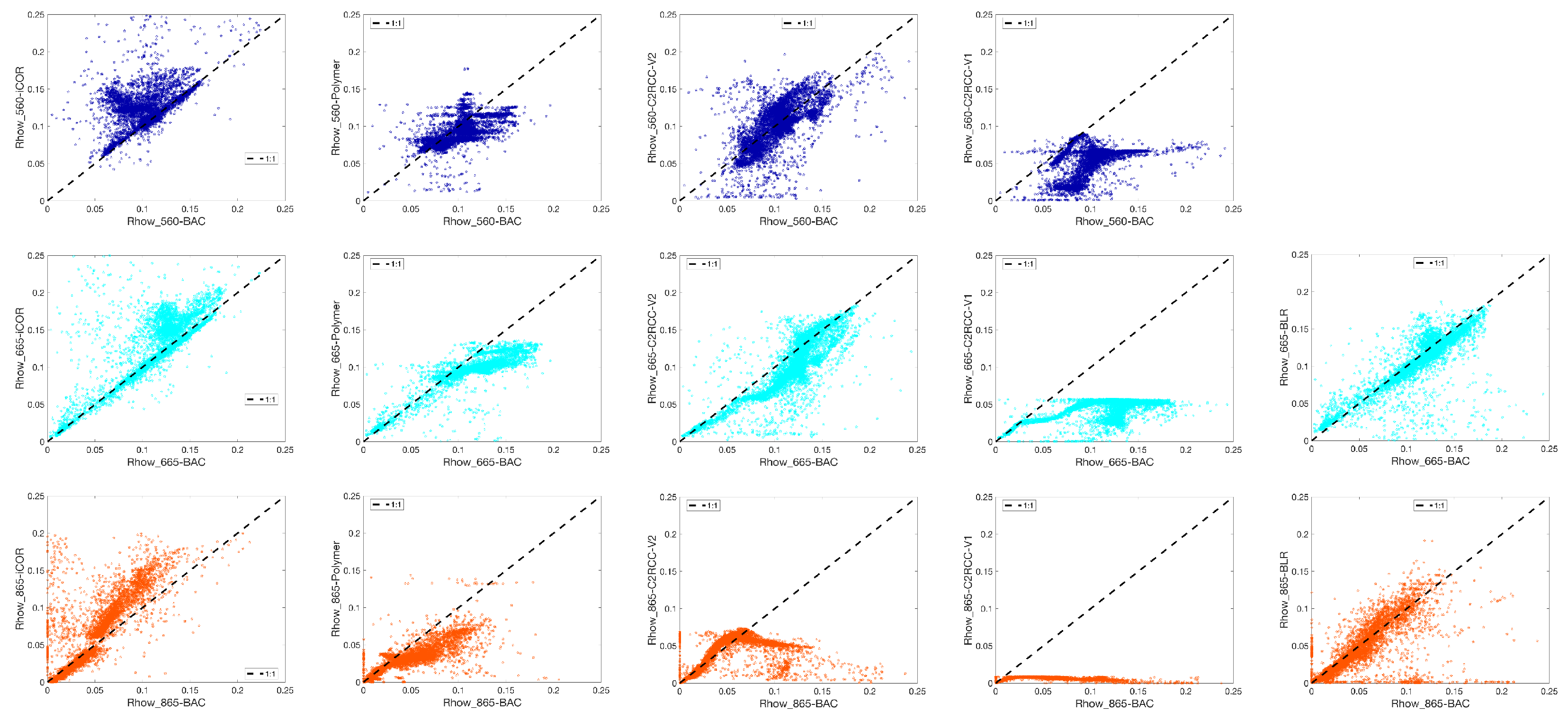
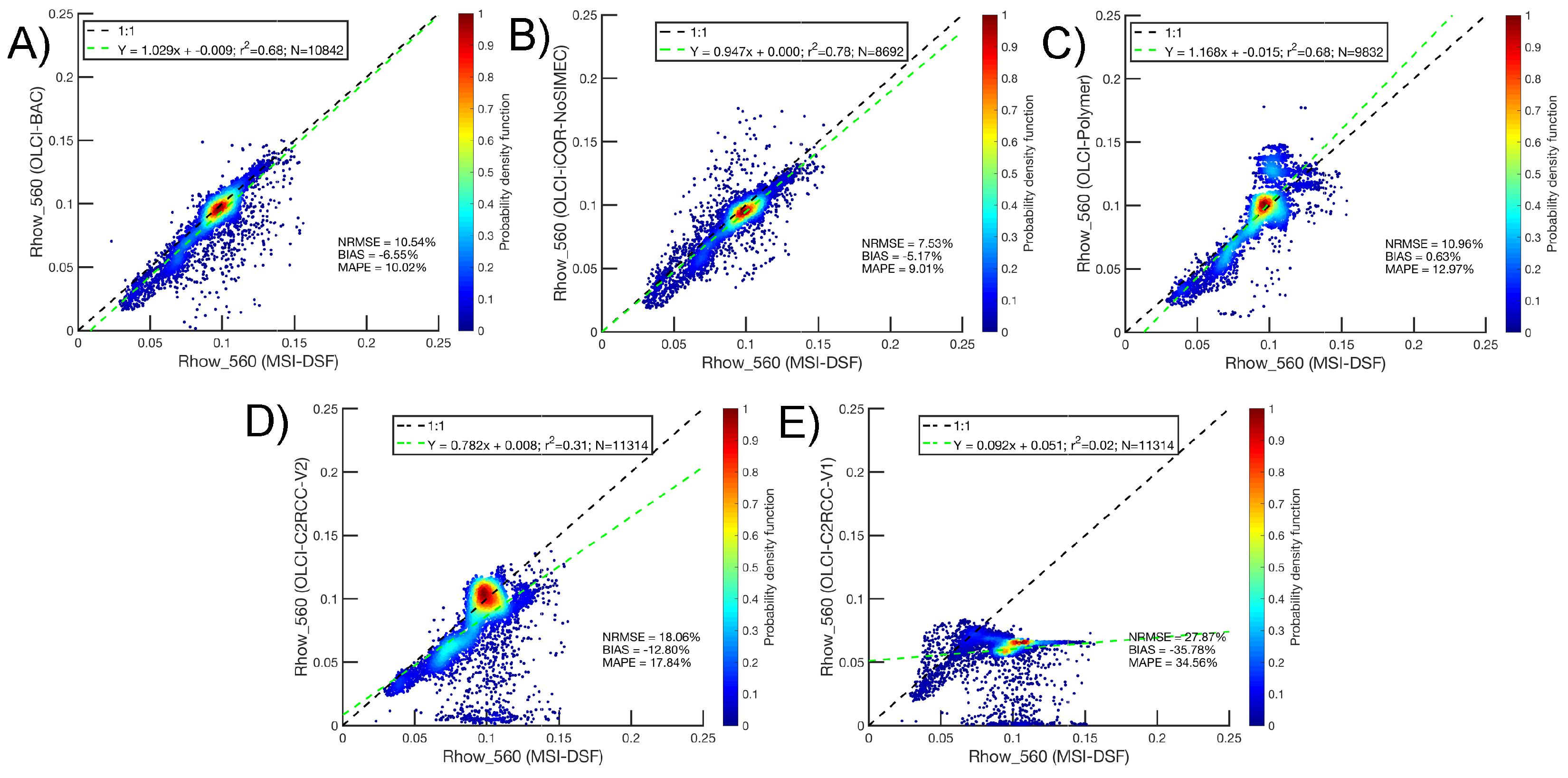
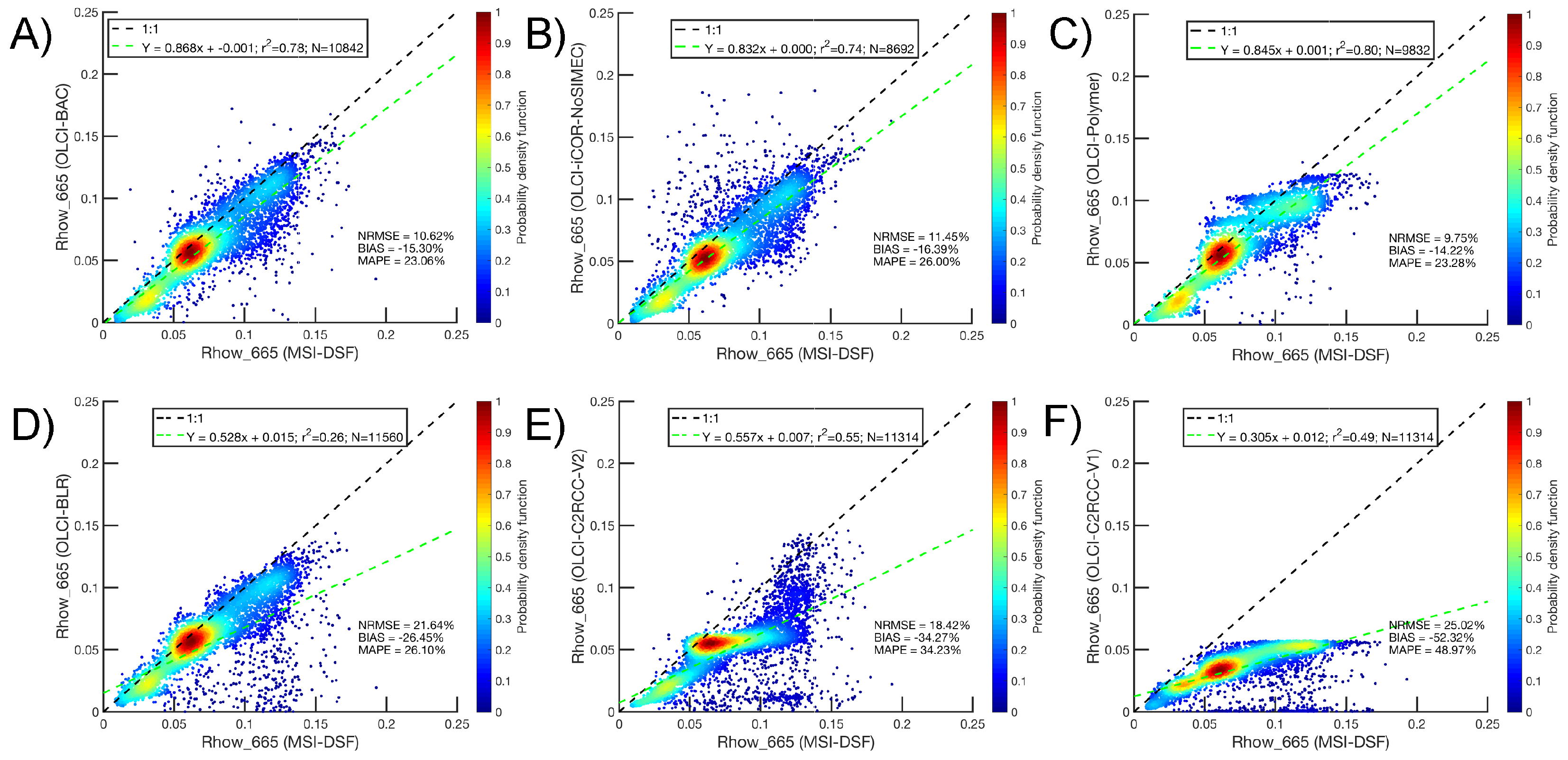

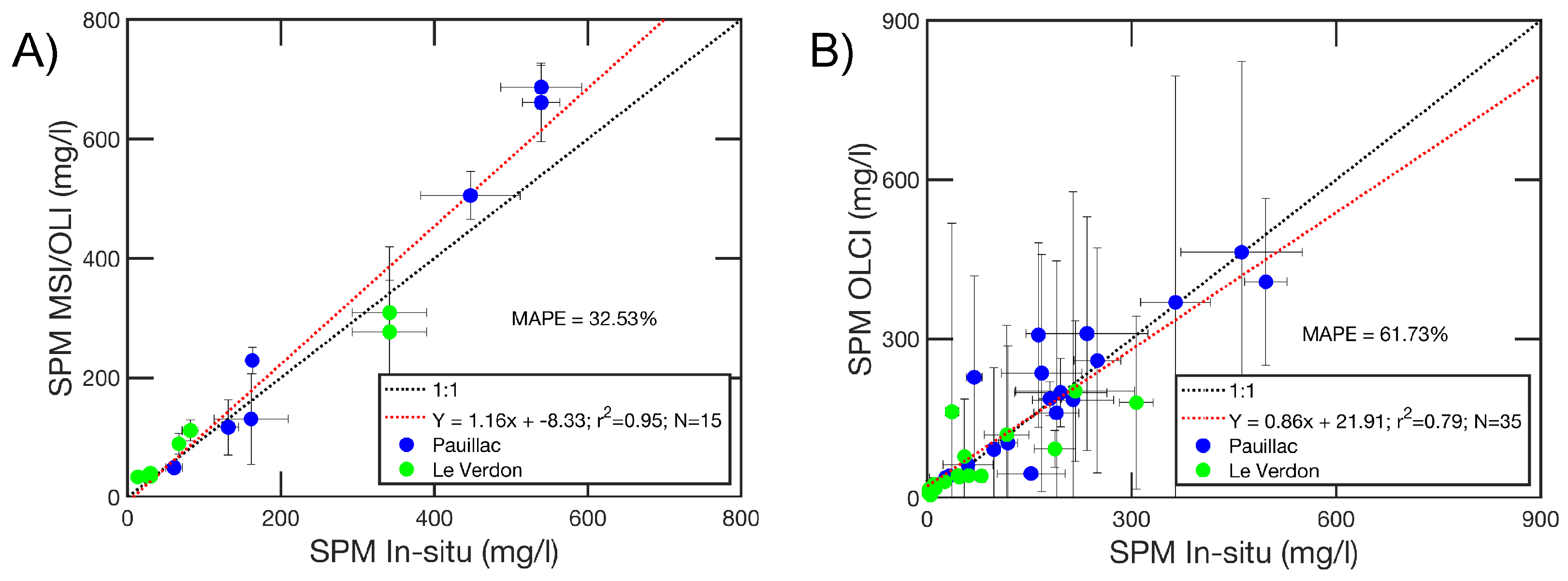
| Date | Tide | Tide | TR (m) | SZA () | Pau-AOT865 | Ver-AOT865 | OLCI | MSI | OLI |
|---|---|---|---|---|---|---|---|---|---|
| 25/02/2018 | 06:19 LW | 12:48 HW | 3.18 | 61.19 | 0.22 ± 0.19 | 0.23 ± 0.19 | 10:11 | ||
| 16/04/2018 | 04:55 HW | 11:34 LW | 5.02 | 42.09 | NaN | 0.30 ± 0.20 | 10:15 | ||
| 19/04/2018 | 06:47 HW | 13:29 LW | 4.78 | 38.65 | 0.61 ± 0.10 | 0.26 ± 0.10 | 10:37 | 11:01 | 10:47 |
| 20/04/2018 | 07:31 HW | 14:08 LW | 4.41 | 41.21 | 0.38 ± 0.15 | 0.26 ± 0.11 | 10:11 | ||
| 04/05/2018 | 07:14 HW | 13:41 LW | 3.90 | 32.96 | 0.43 ± 0.07 | 0.56 ± 0.13 | 10:48 | 11:02 | |
| 05/05/2018 | 07:49 HW | 14:13 LW | 3.40 | 35.50 | 0.65 ± 0.18 | 0.38 ± 0.11 | 10:22 | 10:46 | |
| 20/05/2018 | 08:24 HW | 14:49 LW | 3.99 | 30.95 | 0.39 ± 0.21 | 0.25 ± 0.14 | 10:33 | ||
| 20/06/2018 | 10:17 HW | 16:35 LW | 3.62 | 29.17 | 0.23 ± 0.17 | 0.21 ± 0.19 | 10:30 | ||
| 25/06/2018 | 09:15 LW | 15:22 HW | 3.97 | 33.61 | 0.31 ± 0.19 | 0.13 ± 0.12 | 10:00 | ||
| 28/06/2018 | 04:57 HW | 11:18 LW | 4.10 | 30.54 | 0.40 ± 0.22 | 0.17 ± 0.16 | 10:22 | 11:06 | |
| 09/07/2018 | 07:26 LW | 13:40 HW | 3.58 | 29.59 | 0.32 ± 0.14 | 0.21 ± 0.06 | 10:37 | ||
| 10/07/2018 | 08:30 LW | 14:35 HW | 4.08 | 33.26 | 0.38 ± 0.17 | 0.23 ± 0.06 | 10:11 | ||
| 25/07/2018 | 09:37 LW | 15:46 HW | 3.80 | 33.96 | 0.53 ± 0.21 | 0.34 ± 0.14 | 10:22 | ||
| 02/08/2018 | 07:55 HW | 14:23 LW | 3.84 | 36.48 | 0.26 ± 0.18 | 0.10 ± 0.04 | 10:15 | 10:59 | |
| 05/08/2018 | 04:25 LW | 10:37 HW | 3.08 | 34.32 | 0.18 ± 0.14 | 0.22 ± 0.13 | 10:37 | ||
| 06/08/2018 | 05:33 LW | 12:01 HW | 3.05 | 37.81 | 0.23 ± 0.15 | 0.25 ± 0.10 | 10:11 | ||
| 18/08/2018 | 09:54 HW | 16:22 LW | 3.23 | 42.03 | 0.29 ± 0.24 | 0.19 ± 0.19 | 10:00 | ||
| 22/08/2018 | 08:21 LW | 14:45 HW | 3.09 | 43.50 | 0.23 ± 0.17 | 0.26 ± 0.19 | 09:57 | 11:04 | |
| 01/09/2018 | 08:06 HW | 14:39 LW | 3.89 | 41.52 | 0.08 ± 0.14 | 0.09 ± 0.08 | 10:37 | 10:59 | 10:53 |
| 02/09/2018 | 08:52 HW | 15:24 LW | 3.50 | 44.56 | 0.16 ± 0.20 | 0.44 ± 0.26 | 10:11 | ||
| 12/09/2018 | 06:25 HW | 13:02 LW | 5.17 | 43.82 | 0.27 ± 0.19 | 0.21 ± 0.19 | 10:52 | ||
| 17/09/2018 | 10:09 HW | 16:42 LW | 2.46 | 47.96 | 0.16 ± 0.13 | 0.23 ± 0.14 | 10:22 | 10:53 | |
| 20/09/2018 | 07:49 LW | 14:17 HW | 2.74 | 47.08 | 0.23 ± 0.26 | 0.56 ± 0.29 | 10:45 | ||
| 24/09/2018 | 04:18 HW | 10:43 LW | 4.40 | 48.74 | 0.24 ± 0.19 | 0.27 ± 0.23 | 10:41 |
| L8-OLI | S2-MSI | S3-OLCI |
|---|---|---|
| Acolite DSF/SWIR | Acolite DSF | BAC |
| iCOR (NoSIMEC and SIMEC) | iCOR (NoSIMEC and SIMEC) | iCOR (NoSIMEC and SIMEC) |
| Polymer | Polymer | |
| C2RCC | BLR | |
| C2RCC-V1 | ||
| C2RCC-V2 |
| AC Algorithm | Slope | NRMSE % | BIAS % | MAPE % | |
|---|---|---|---|---|---|
| iCOR-NoSIMEC | 1.0 ± 0.15 | 0.71 ± 0.1 | 9.64 ± 4.49 | 1.98 ± 4.54 | 11.78 ± 5.05 |
| iCOR-SIMEC | 1.06 ± 0.14 | 0.74 ± 0.1 | 9.42 ± 4.31 | 0.79 ± 5.10 | 11.70 ± 5.18 |
| BAC | 0.73 ± 0.20 | 0.41 ± 0.29 | 15.71 ± 6.05 | −12.97 ± 4.08 | 16.72 ± 4.38 |
| Polymer | 0.68 ± 0.35 | 0.49 ± 0.31 | 15.41 ± 7.57 | −14.70 ± 10.76 | 18.60 ± 6.32 |
| C2RCC-V2 | 0.82 ± 0.19 | 0.39 ± 0.14 | 18.46 ± 4.37 | −16.81 ± 5.95 | 19.66 ± 3.06 |
| C2RCC-V1 | 0.19 ± 0.25 | 0.13 ± 0.19 | 31.53 ± 13.79 | −27.20 ± 34.37 | 39.26 ± 14.29 |
| AC Algorithm | Slope | NRMSE % | BIAS % | MAPE % | |
|---|---|---|---|---|---|
| iCOR-NoSIMEC | 1.0 ± 0.17 | 0.75 ± 0.12 | 10.92 ± 3.10 | −9.78 ± 8.70 | 27.85 ± 20.15 |
| iCOR-SIMEC | 1.02 ± 0.14 | 0.77 ± 0.11 | 10.69 ± 3.07 | −7.65 ± 9.63 | 27.50 ± 20.32 |
| BAC | 0.82 ± 0.07 | 0.7 ± 0.14 | 11.95 ± 2.77 | −17.21 ± 9.78 | 27.03 ± 16.55 |
| Polymer | 0.64 ± 0.20 | 0.68 ± 0.25 | 15.5 ± 6.80 | −25.52 ± 8.15 | 30.36 ± 8.41 |
| C2RCC-V2 | 0.74 ± 0.18 | 0.61 ± 0.16 | 18.02 ± 3.79 | −29.40 ± 8.76 | 31.60 ± 7.84 |
| BLR | 0.66 ± 0.22 | 0.34 ± 0.11 | 21.19 ± 4.65 | −26.61 ± 7.94 | 27.78 ± 7.10 |
| C2RCC-V1 | 0.22 ± 0.2 | 0.36 ± 0.28 | 32.85 ± 15.56 | −56.61 ± 8.22 | 54.75 ± 8.66 |
| AC Algorithm | Slope | NRMSE % | BIAS % | MAPE % | |
|---|---|---|---|---|---|
| BAC | 0.70 ± 0.13 | 0.43 ± 0.17 | 12.71 ± 4.36 | −32.56 ± 17.01 | 54.69 ± 19.92 |
| iCOR-NoSIMEC | 0.83 ± 0.22 | 0.38 ± 0.29 | 18.68 ± 7.75 | 11.23 ± 72.44 | 112.48 ± 96.60 |
| iCOR-SIMEC | 0.89 ± 0.20 | 0.38 ± 0.28 | 19.03 ± 6.68 | −5.24 ± 68.03 | 125.07 ± 91.00 |
| BLR | 0.63 ± 0.13 | 0.43 ± 0.21 | 14.0 ± 4.56 | −43.92 ± 13.79 | 60.94 ± 19.68 |
| C2RCC-V2 | 0.35 ± 0.12 | 0.46 ± 0.15 | 13.89 ± 6.82 | −51.07 ± 13.88 | 54.65 ± 15.38 |
| Polymer | 0.40 ± 0.09 | 0.48 ± 0.06 | 13.95 ± 8.91 | −53.84 ± 9.81 | 58.35 ± 12.93 |
| C2RCC-V1 | 0.04 ± 0.04 | 0.17 ± 0.11 | 22.69 ± 14.78 | −83.37 ± 5.70 | 78.91 ± 6.37 |
© 2020 by the authors. Licensee MDPI, Basel, Switzerland. This article is an open access article distributed under the terms and conditions of the Creative Commons Attribution (CC BY) license (http://creativecommons.org/licenses/by/4.0/).
Share and Cite
Renosh, P.R.; Doxaran, D.; Keukelaere, L.D.; Gossn, J.I. Evaluation of Atmospheric Correction Algorithms for Sentinel-2-MSI and Sentinel-3-OLCI in Highly Turbid Estuarine Waters. Remote Sens. 2020, 12, 1285. https://doi.org/10.3390/rs12081285
Renosh PR, Doxaran D, Keukelaere LD, Gossn JI. Evaluation of Atmospheric Correction Algorithms for Sentinel-2-MSI and Sentinel-3-OLCI in Highly Turbid Estuarine Waters. Remote Sensing. 2020; 12(8):1285. https://doi.org/10.3390/rs12081285
Chicago/Turabian StyleRenosh, Pannimpullath Remanan, David Doxaran, Liesbeth De Keukelaere, and Juan Ignacio Gossn. 2020. "Evaluation of Atmospheric Correction Algorithms for Sentinel-2-MSI and Sentinel-3-OLCI in Highly Turbid Estuarine Waters" Remote Sensing 12, no. 8: 1285. https://doi.org/10.3390/rs12081285
APA StyleRenosh, P. R., Doxaran, D., Keukelaere, L. D., & Gossn, J. I. (2020). Evaluation of Atmospheric Correction Algorithms for Sentinel-2-MSI and Sentinel-3-OLCI in Highly Turbid Estuarine Waters. Remote Sensing, 12(8), 1285. https://doi.org/10.3390/rs12081285






